Effect of Segregation Band on the Microstructure and Properties of a Wind Power Steel before and after Simulated Welding
Abstract
:1. Introduction
2. Materials and Methods
3. Results
3.1. Tensile Properties and Impact Toughness of Base Metal
3.2. Microstructure Evolution in Base Metal
3.3. Impact Toughness and Fractographs of Thermal Simulated Samples
3.4. Microstructure Evolution in Thermal Simulated Samples and Phase Transformation Mechanism
3.5. Overall Discussion
4. Conclusions
- (1)
- Even if the thickness is only 20 mm, the core of wind power steel plates mainly composed of ferrite and pearlite structures will still form a C and Mn segregation band. And the segregation of C and Mn can lead to the formation of martensite and M/A constituent and increase the impact toughness scatter of the matrix.
- (2)
- The centerline segregation of the steel plate can also affect the welding microstructure and properties. Due to the segregation of alloying elements, especially Mn segregation, the tendency for martensite formation in simulated CGHAZ increases, and the hardness of the transformed microstructure is significantly higher than that of the normal microstructure, which can easily lead to a decrease in impact toughness and an increase in scatter.
- (3)
- For the studied steel with yield strength of ~460 MPa used for wind power generation, there is an optimal welding heat input (~20 kJ/cm), which enables the simulated CGHAZ to obtain the highest impact toughness due to the formation of LB structure and the finest crystallographic block units.
Author Contributions
Funding
Data Availability Statement
Acknowledgments
Conflicts of Interest
References
- Zheng, D.D.; Guo, H.C.; Zhang, S.J.; Liu, Y.L. Study on fatigue performance of double cover plate through-core bolted joint of rectangular concrete-filled steel tube bundle wind turbine towers. J. Constr. Steel Res. 2023, 203, 107830. [Google Scholar] [CrossRef]
- Yuan, R.; Pan, Z.D.; Wu, H.B. Effect of normalizing process on microstructure and properties of 420 MPa grade steel plate for offshore wind power. Heat Treat. Met. 2021, 46, 112–116. [Google Scholar]
- Lee, S.; Kim, B.C.; Kwon, D. Correlation of microstructure and fracture properties in weld heat-affected zones of thermomechanically controlled processed steels. Metall. Mater. Trans. A 1992, 23A, 2803–2816. [Google Scholar] [CrossRef]
- Cui, B.; Liu, Z.W.; Liu, Z.; Peng, M.D.; Shi, Q.B.; Cong, J.Q. Effect of welding heat input on microstructural evolution and impact toughness of the simulated coarse-grained heat-affected zone of Q960 steel. Weld. World 2023, 67, 235–249. [Google Scholar] [CrossRef]
- Shao, J.J.; Fei, J.Y.; Zhong, S.F.; Zhao, L.; Xu, L.Y.; Han, Y.D. Microstructure and properties of intercritically reheated coarse-grained heat affected zone in X65 pipeline steel with pre-strain. Int. J. Hydrogen Energy 2024, 49, 1345–1357. [Google Scholar] [CrossRef]
- Lan, L.Y.; Qiu, C.L.; Zhao, D.W.; Gao, X.H.; Du, L.X. Microstructural characteristics and toughness of the simulated coarse grained heat affected zone of high strength low carbon bainitic steel. Mater. Sci. Eng. A 2011, 529, 192–200. [Google Scholar] [CrossRef]
- Moeinifar, S.; Kokabi, A.H.; Madaah Hosseini, H.R. Influence of peak temperature during simulation and real thermal cycles on microstructure and fracture properties of the reheated zones. Mater. Sci. Eng. A 2010, 31, 2948–2955. [Google Scholar] [CrossRef]
- Bertolo, V.; Jiang, Q.; Terol Sanchez, M.; Riemslag, T.; Walters, C.L.; Sietsma, J.; Popovich, V. Cleavage fracture micromechanisms in simulated heat affected zones of S690 high strength steels. Mater. Sci. Eng. A 2023, 868, 144762. [Google Scholar] [CrossRef]
- Shi, Y.W.; Chen, D.; Lei, Y.P.; Li, X.Y. HAZ microstructure simulation in welding of a ultra fine grain steel. Comput. Mater. Sci. 2004, 31, 379–388. [Google Scholar] [CrossRef]
- Yang, Y.L.; Jia, X.; Ma, Y.X.; Wang, P.; Zhu, F.X. Effect of Nb on inclusions and phase transformation in simulated high heat input coarse-grain HAZ of Nb/Ti low carbon microalloyed steel. Mater. Charact. 2022, 189, 111966. [Google Scholar] [CrossRef]
- Sisodia, R.; Weglowski, M.; Sliwinski, P. In situ localised post-weld heat treatment with electron beam welding of S690QL steel. J. Adv. Join. Process. 2024, 9, 100182. [Google Scholar] [CrossRef]
- Zhang, J.; Xin, W.B.; Ge, Z.W.; Luo, G.P.; Peng, J. Effect of high heat input welding on the microstructures, precipitates and mechanical properties in the simulated coarse grained heat affected zone of a low carbon Nb-V-Ti-N microalloyed steel. Mater. Charact. 2023, 199, 112849. [Google Scholar] [CrossRef]
- Liu, Z.P.; Xie, Z.J.; Luo, D.; Zhou, W.H.; Guo, H.; Shang, C.J. Influence of central segregation on the welding microstructure and properties of FH40 cryogenic steel. Chin. J. Eng. 2023, 45, 1335–1341. [Google Scholar]
- Abraham Mathews, J.; Sietsma, J.; Petrov, R.H.; Santofimia, M.J. Influence of chemical segregation on bainitic microstructures in a carburized bearing steel. Mater. Des. 2022, 223, 111232. [Google Scholar] [CrossRef]
- Wang, J.L.; Qian, R.T.; Yang, X.; Zhong, Y.; Shang, C.J. Effect of segregation on the microstructure and properties of a quenching and partitioning steel. Mater. Lett. 2022, 325, 132815. [Google Scholar] [CrossRef]
- Li, W.G.; Zhou, Q.J.; Wu, W.J.; Tong, Y.X.; Li, J.X. Effect of the segregation band on the hydrogen embrittlement susceptibility of quenched and partitioned steel. Corros. Sci. 2023, 22, 111436. [Google Scholar] [CrossRef]
- Han, P.; Liu, Z.P.; Xie, Z.J.; Wang, H.; Jin, Y.H.; Wang, X.L.; Shang, C.J. Influence of band microstructure on carbide precipitation behavior and toughness of 1 GPa-grade ultra-heavy gauge low-alloy steel. Int. J. Miner. Metall. Mater. 2023, 30, 1329–1337. [Google Scholar] [CrossRef]
- Shi, L.; Long, J.; Pang, H.Y.; Lin, M.X.; Zhang, H.J.; Wu, T. Study on microstructure and low temperature impact toughness of large thickness steel for offshore wind power. J. Chongqing Univ. 2023, 1–9. Available online: https://link.cnki.net/urlid/50.1044.n.20231120.2011.002 (accessed on 21 November 2023).
- Kitahara, H.; Ueji, R.; Tsuji, N.; Minamino, Y. Crystallographic features of lath martensite in low-carbon steel. Acta Mater. 2006, 54, 1279–1288. [Google Scholar] [CrossRef]
- Lambert-Perlade, A.; Sturel, T.; Gourgues, A.F.; Besson, J.; Pineau, A. Mechanisms and modeling of cleavage fracture in simulated heat-affected zone microstructures of a high-strength low alloy steel. Metall. Mater. Trans. A 2004, 35, 1039–1053. [Google Scholar] [CrossRef]
- E8/E8M-16a; Standard Test Methods for Tension Testing of Metallic Materials. ASTM: West Conshohocken, PA, USA, 2016.
- E384-9; Standard Test Method for Microindentation Hardness of Materials. ASTM: West Conshohocken, PA, USA, 2009.
- Zhang, N.Z.; Zhao, H.T.; Zhou, F.; Chen, X.M.; Bao, L.J.; Shi, G. Mechanical properties and constitutive model of Q345GJ thick steel plate in China. Constr. Build. Mater. 2023, 406, 133288. [Google Scholar] [CrossRef]
- GB/T 1591-2018; High Strength Low Alloy Structural Steels. China Iron and Steel Association: Beijing, China, 2018.
- Domizzi, G.; Anteri, G.; Ovejero-Garcıa, J. Influence of sulphur content and inclusion distribution on the hydrogen induced blister cracking in pressure vessel and pipeline steels. Corros. Sci. 2001, 43, 325–339. [Google Scholar] [CrossRef]
- Xie, Z.J.; Li, Q.; Liu, Z.P.; Zhou, W.J.; Wang, X.L.; Yu, Q.; Xiao, D.H.; Shang, C.J. Enhanced ductility and toughness by tailoring heterogenous microstructure in an ultra-heavy gauge high strength steel with severe centerline segregation. Mater. Lett. 2022, 323, 132525. [Google Scholar] [CrossRef]
- Yang, X.C.; Di, X.J.; Liu, X.G.; Wang, D.P.; Li, C.N. Effects of heat input on microstructure and fracture toughness of simulated coarse-grained heat affected zone for HSLA steels. Mater. Charact. 2019, 155, 109818. [Google Scholar] [CrossRef]
- Gou, J.X.; Xing, X.; Cui, G.; Li, Z.L.; Liu, J.G.; Deng, X.Y.; Cheng, Y.F. Effect of hydrogen on impact fracture of X80 steel weld: Various heat inputs and coarse grain heat-affected zone. Mater. Sci. Eng. A 2023, 886, 145673. [Google Scholar] [CrossRef]
- Wang, X.L.; Su, W.J.; Xie, Z.J.; Li, X.C.; Zhou, W.H.; Shang, C.J.; Wang, Q.C.; Bai, J.; Wu, L.Q. Microstructure evolution of heat-afected zone in submerged arc welding and laser hybrid welding of 690 MPa high strength steel and its relationship with ductile-brittle transition temperature. Acta Metall. Sin. Engl. Lett. 2023, 36, 623–636. [Google Scholar] [CrossRef]
- Takayama, N.; Miyamoto, G.; Furuhara, T. Effects of transformation temperature on variant pairing of bainitic ferrite in low carbon steel. Acta Mater. 2012, 60, 2387–2396. [Google Scholar] [CrossRef]
- Morito, S.; Huang, X.; Furuhara, T.; Maki, T.; Hansen, N. The morphology and crystallography of lath martensite in alloy steels. Acta Mater. 2006, 54, 5323–5331. [Google Scholar] [CrossRef]
- Qi, X.N.; Huan, P.C.; Wang, X.N.; Di, H.S.; Shen, X.J.; Sun, Q.; Liu, Z.G.; He, J.R. Study on the mechanism of heat input on the grain boundary distribution and impact toughness in CGHAZ of X100 pipeline steel from the aspect of variant. Mater. Charact. 2021, 179, 111344. [Google Scholar] [CrossRef]
- Terasaki, H.; Shintome, Y.; Komizo, Y.I.; Ohata, M.; Moriguchi, K.; Tomio, Y. Effect of close-packed plane boundaries in a Bain zone on the crack path in simulated coarsegrained HAZ of bainitic steel. Metall. Mater. Trans. A 2015, 46, 2035–2039. [Google Scholar] [CrossRef]
- Gourgues, A.F. Electron backscatter diffraction and cracking. Mater. Sci. Technol. 2012, 18, 119–133. [Google Scholar] [CrossRef]
- Chakrabarti, D.; Strangwood, M.; Davis, C.L. Effect of bimodal grain size distribution on scatter in toughness. Metall. Mater. Trans. A 2009, 40, 780–795. [Google Scholar] [CrossRef]
- Kang, S.; Speer, J.G.; Regier, R.W.; Nako, H.; Kennett, S.C.; Findley, K.O. The analysis of bainitic ferrite microstructure in microalloyed plate steels through quantitative characterization of intervariant boundarie. Mater. Sci. Eng. A 2016, 669, 459–468. [Google Scholar] [CrossRef]
- Furuhara, T.; Takayama, N.; Miyamoto, G. Key factors in grain refinement of martensite and bainite. Mater. Sci. Forum 2010, 638, 3044–3049. [Google Scholar] [CrossRef]

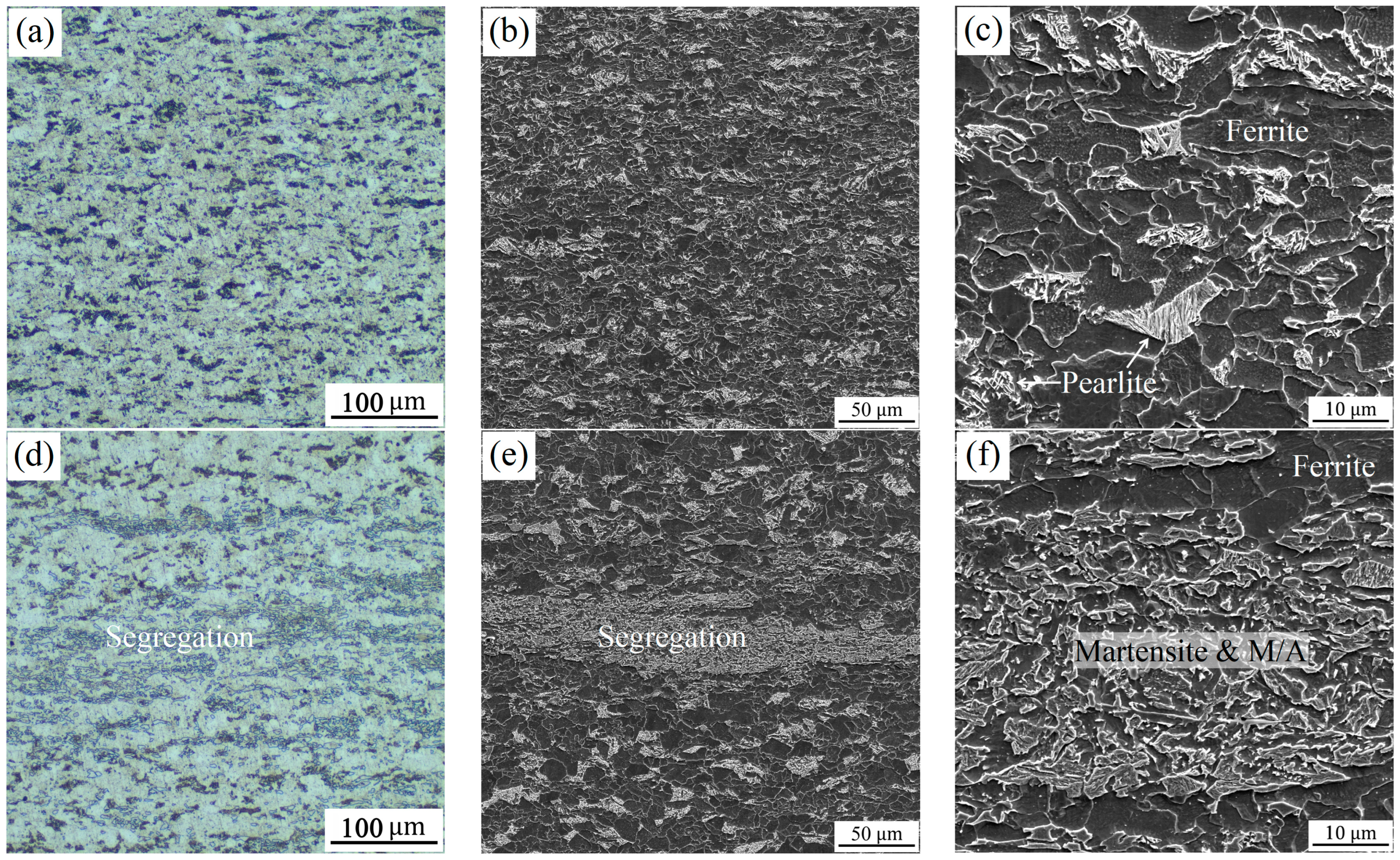
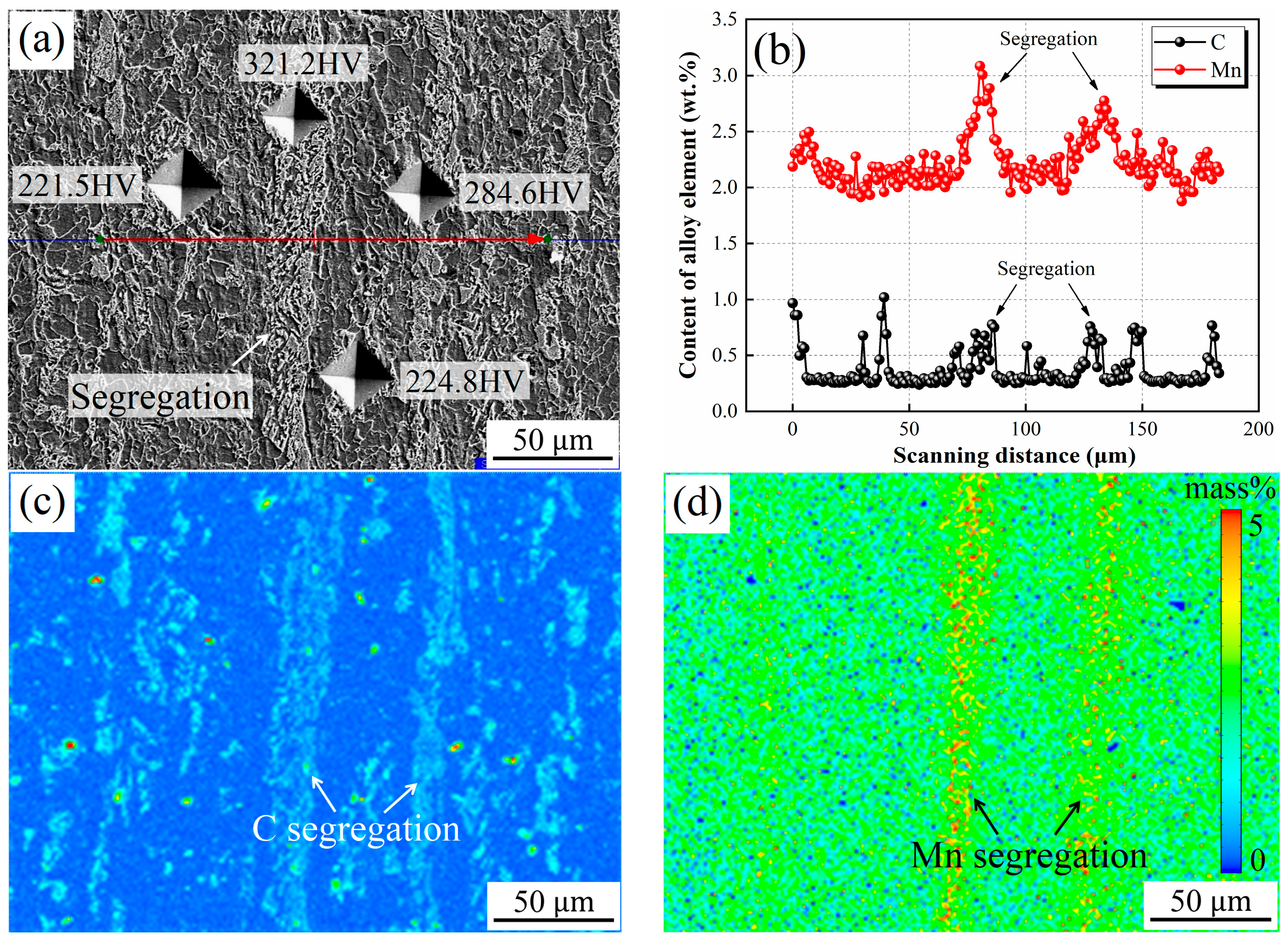
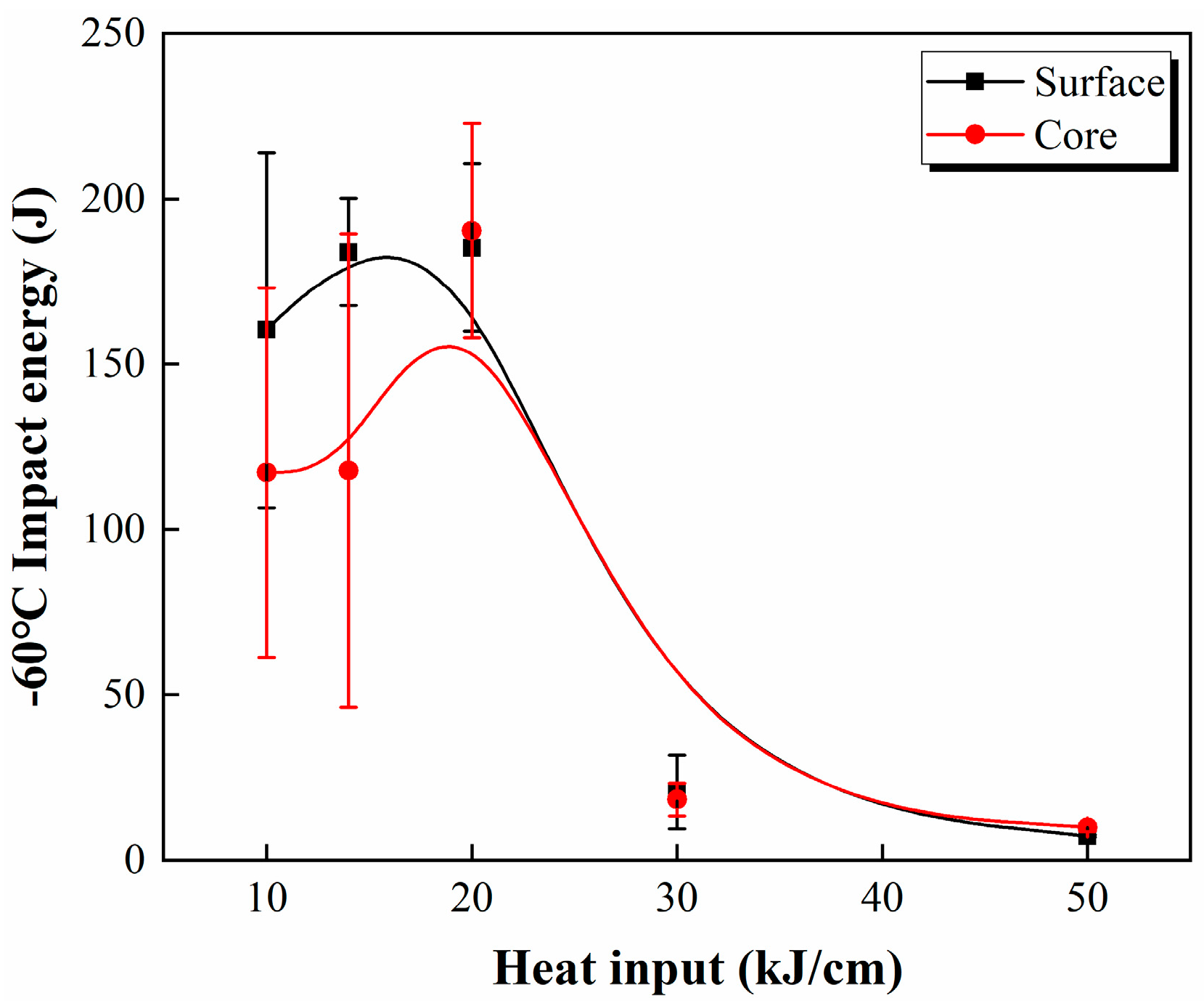
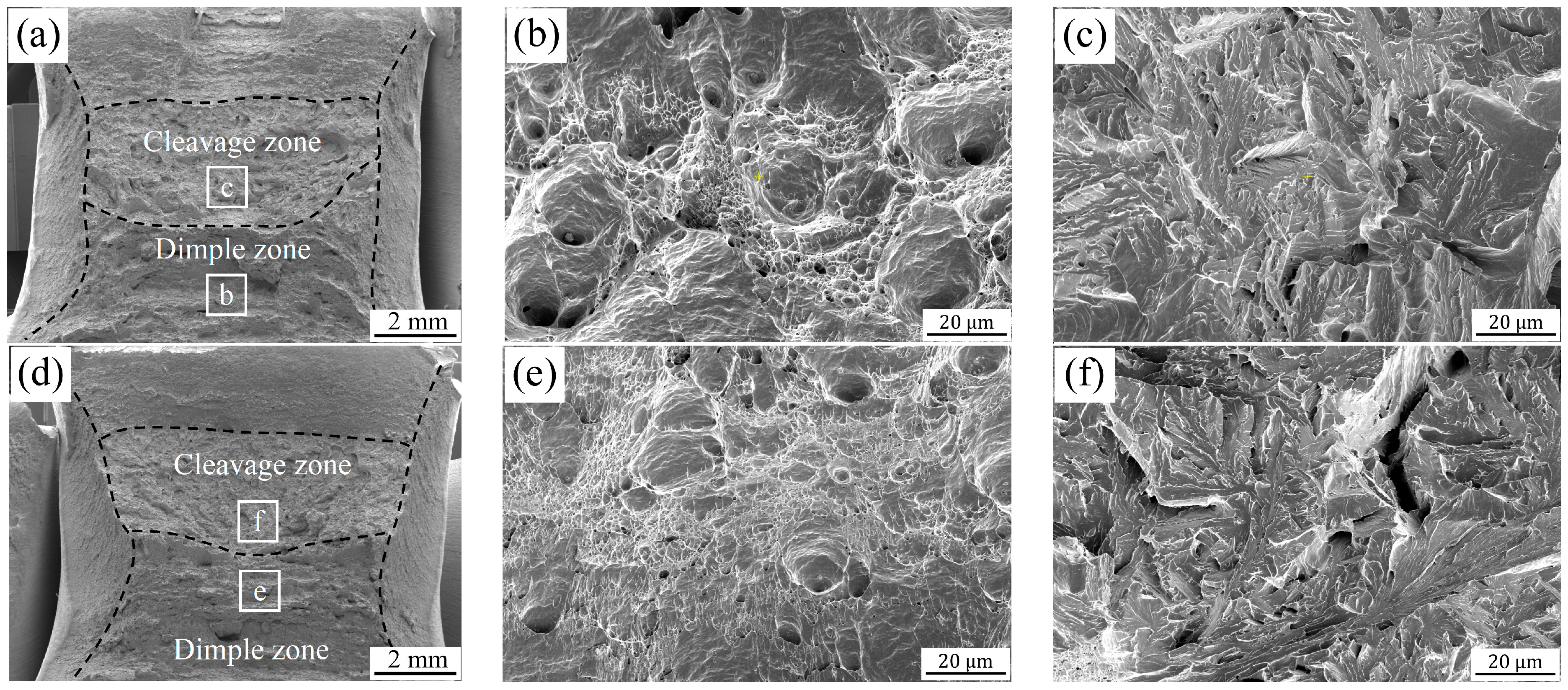

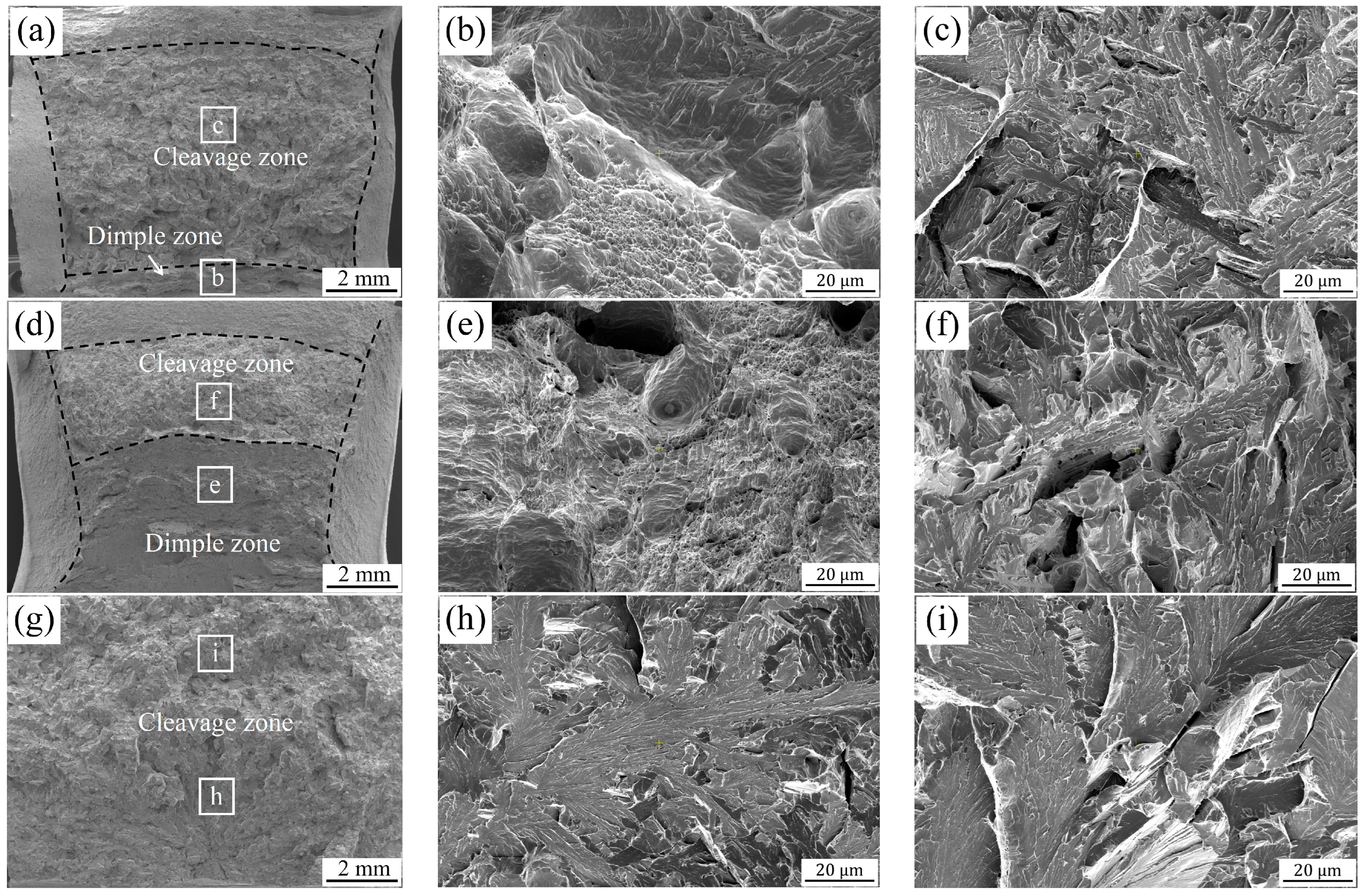
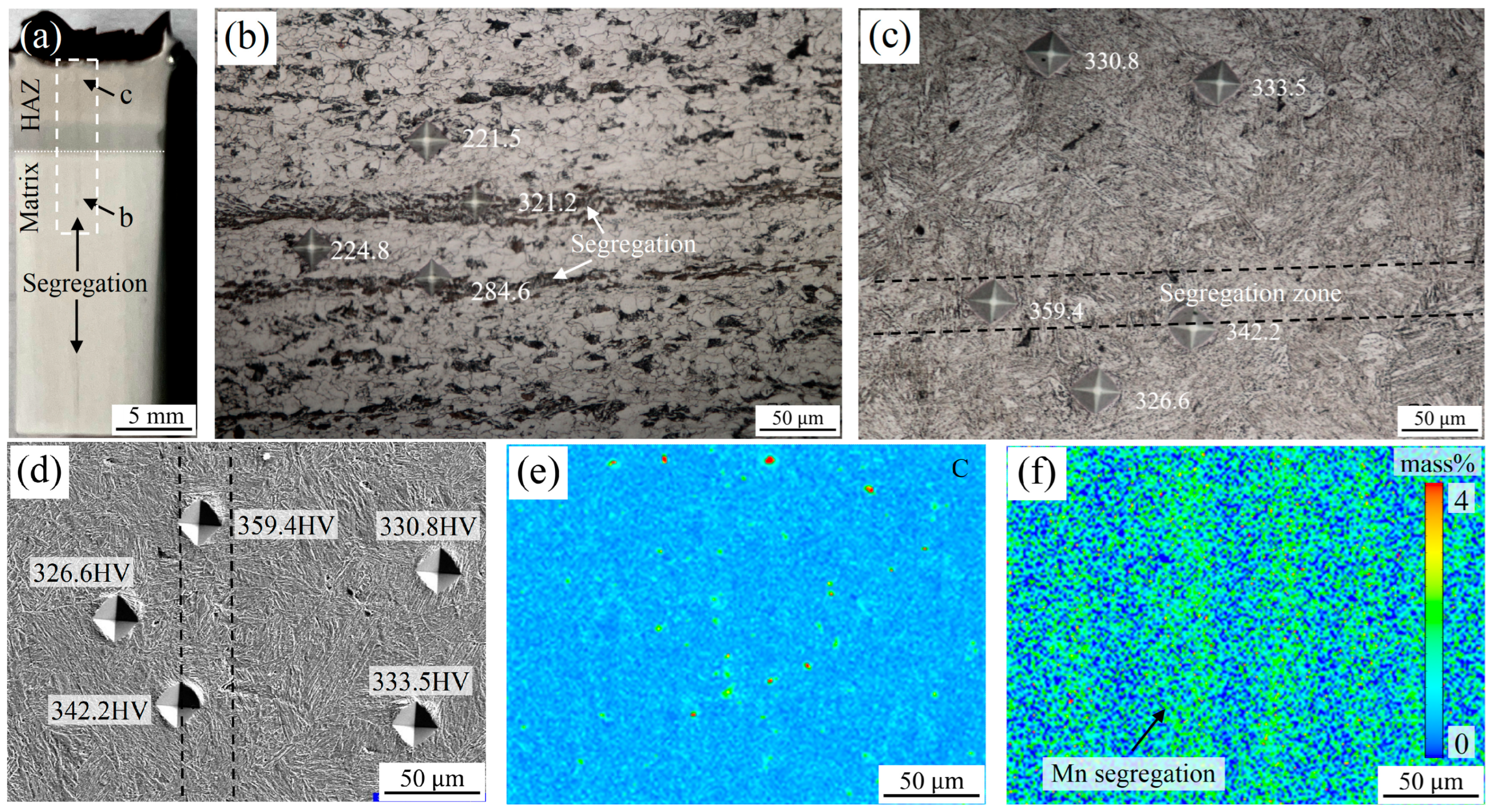


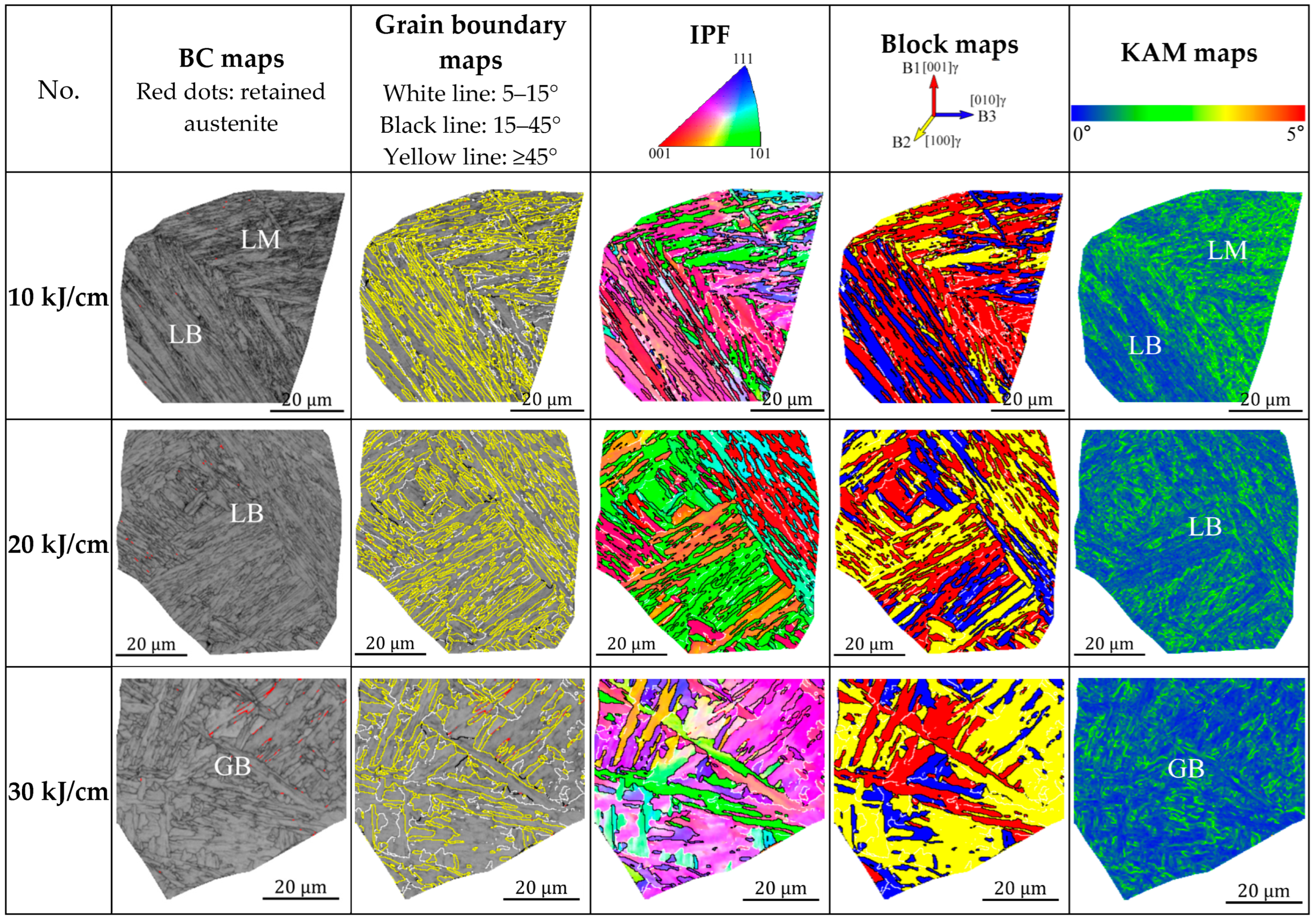
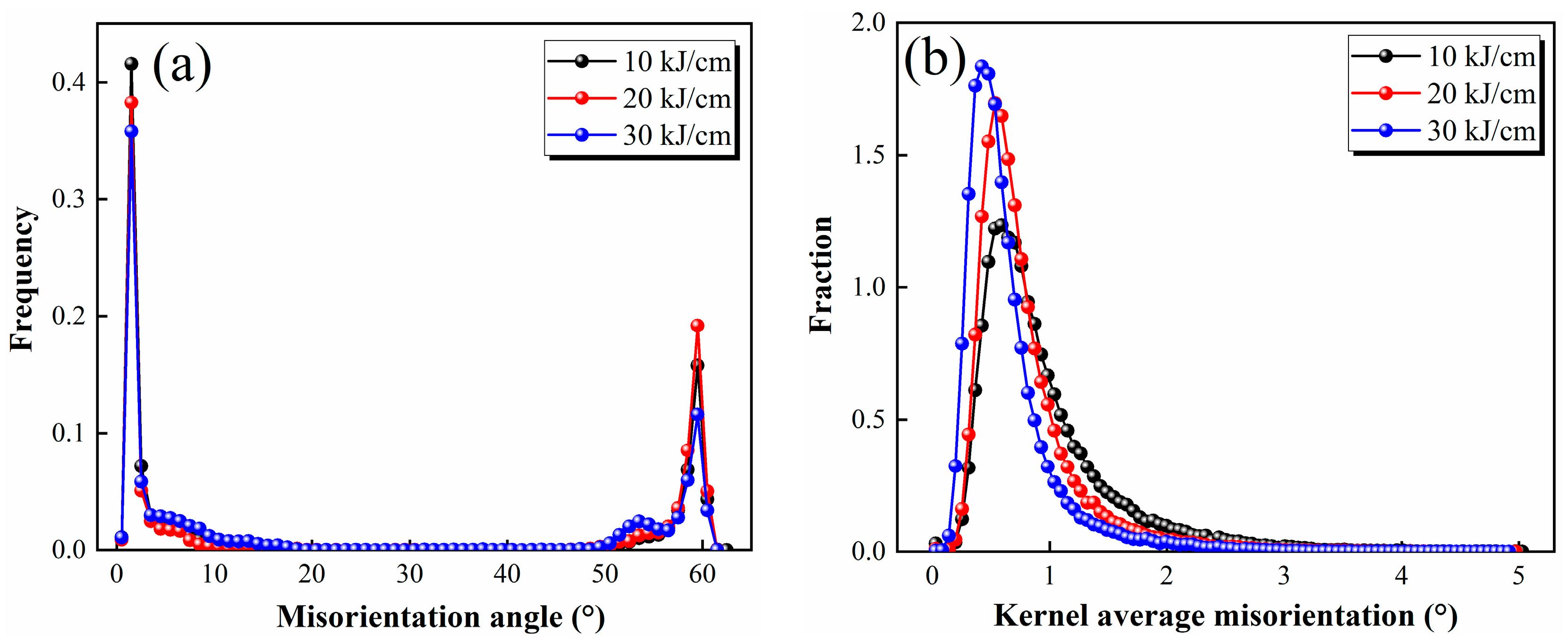

| C | Si | Mn | P | S | Cr | Ni | Nb | Ti |
|---|---|---|---|---|---|---|---|---|
| 0.10 | 0.22 | 1.64 | 0.008 | 0.002 | 0.35 | 0.17 | 0.002 | 0.019 |
Disclaimer/Publisher’s Note: The statements, opinions and data contained in all publications are solely those of the individual author(s) and contributor(s) and not of MDPI and/or the editor(s). MDPI and/or the editor(s) disclaim responsibility for any injury to people or property resulting from any ideas, methods, instructions or products referred to in the content. |
© 2024 by the authors. Licensee MDPI, Basel, Switzerland. This article is an open access article distributed under the terms and conditions of the Creative Commons Attribution (CC BY) license (https://creativecommons.org/licenses/by/4.0/).
Share and Cite
Wang, X.; Wang, X.; Liu, W.; Shang, C. Effect of Segregation Band on the Microstructure and Properties of a Wind Power Steel before and after Simulated Welding. Metals 2024, 14, 129. https://doi.org/10.3390/met14010129
Wang X, Wang X, Liu W, Shang C. Effect of Segregation Band on the Microstructure and Properties of a Wind Power Steel before and after Simulated Welding. Metals. 2024; 14(1):129. https://doi.org/10.3390/met14010129
Chicago/Turabian StyleWang, Xuelin, Xiaoya Wang, Wenle Liu, and Chengjia Shang. 2024. "Effect of Segregation Band on the Microstructure and Properties of a Wind Power Steel before and after Simulated Welding" Metals 14, no. 1: 129. https://doi.org/10.3390/met14010129





